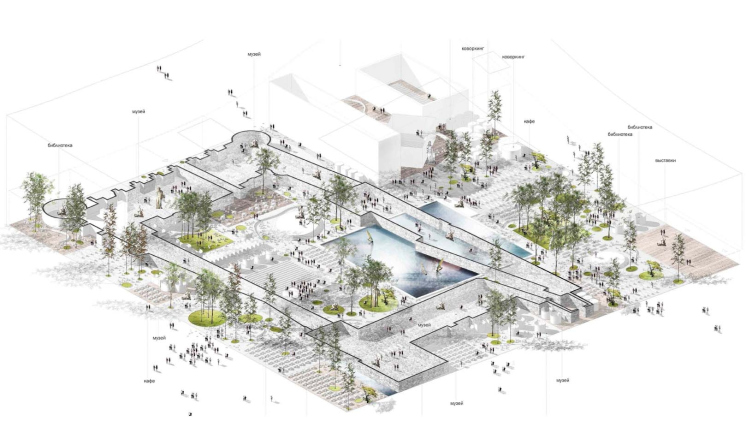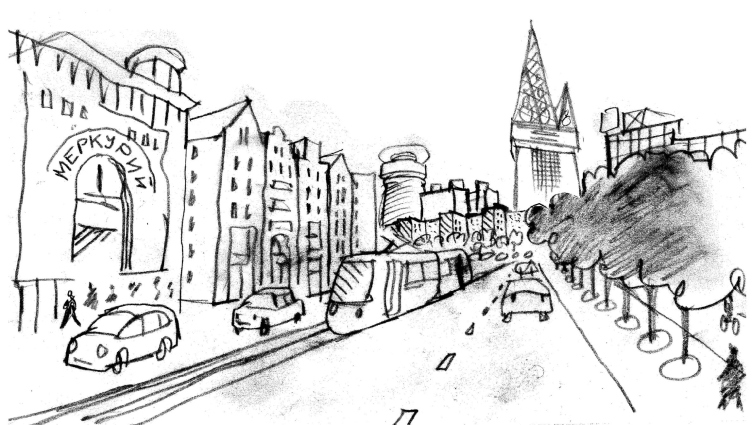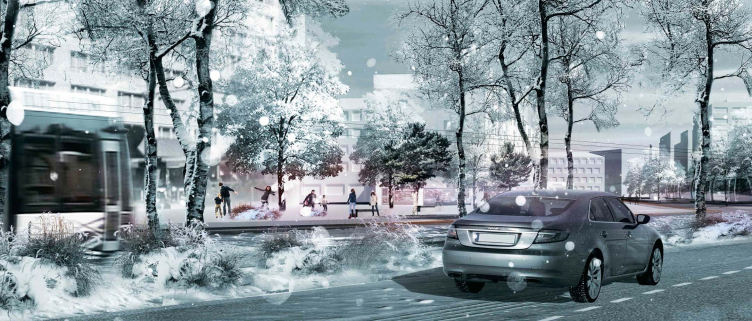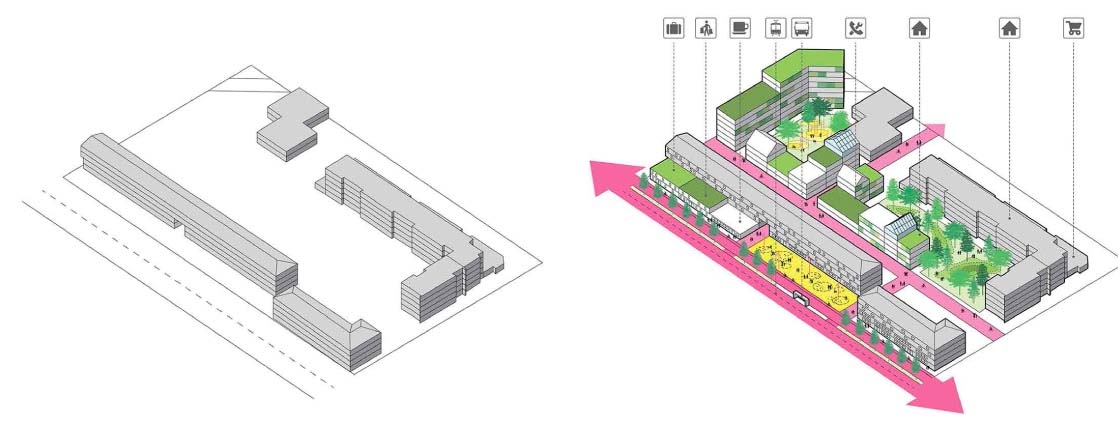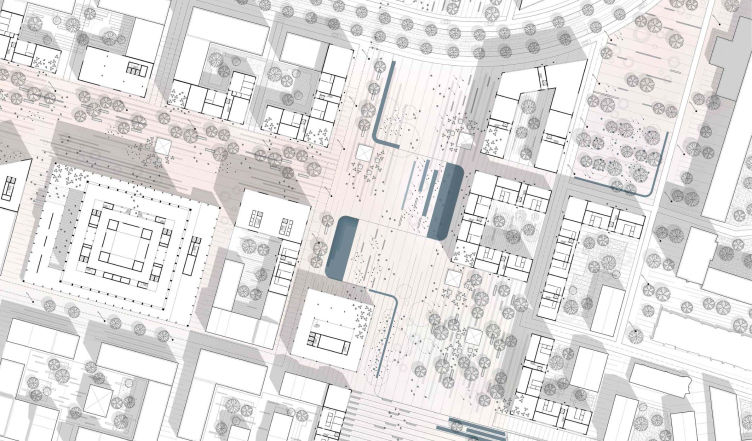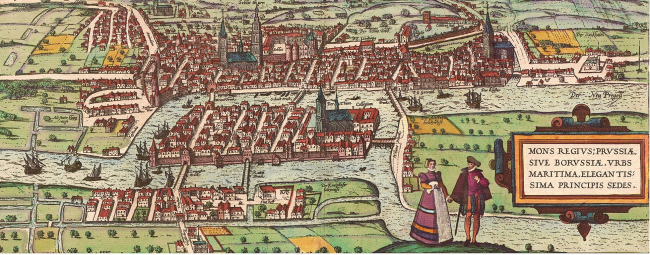
Plan of Koenigsberg by Braun, 1581 Source: Town-planning bureau “Heart of the City”, www.tuwangste.ru
The subject of the contest was the King's Mountain (actually, this is how the name of Koenigsberg translates from German) with the remnants of the king's castle founded back in 1255 and its immediate surroundings where during the Middle Ages there were the towns of Alpstadt, Lebenicht, Kneipfhof, and Vorstadt, as well as the Lomse Island lying at the junction of the Old and New Pregola rivers. This oldest district of Koenigsberg was almost completely destroyed by the bombings during the WWII. All that survived was the gothic cathedral on the island (1333–1380) with the grave of Immanuel Kant in it, the building of the Stock Exchange of 1875; the Jewish orphanage of 1904 and a few other buildings. Also, two bridges survived, the Medovy ("Honey") and the Derevyanny ("Wooden") that made the list of the famous seven bridges one had to cross without stepping on a single one of them twice - a problem that was scientifically proved unsolvable in 1736 by Leonhard Euler who concurrently to that developed the theory of graphs and founded the science of topology.
Today, there is nothing left of Koenigsberg's traditional orthogonal planning grid and its dense array of houses (8,6х9х20 meters, the last figure being the "depth" of the house growing into the land plot); the center of the once-famous city turned into a place bleak and hostile with a giant House of the Soviets standing next to the ruined castle and the high-rises. The contestants had a task of turning this war-mangled territory into something of value, breathe a new live into this land, at the same time connecting it with the past by making its history come alive.
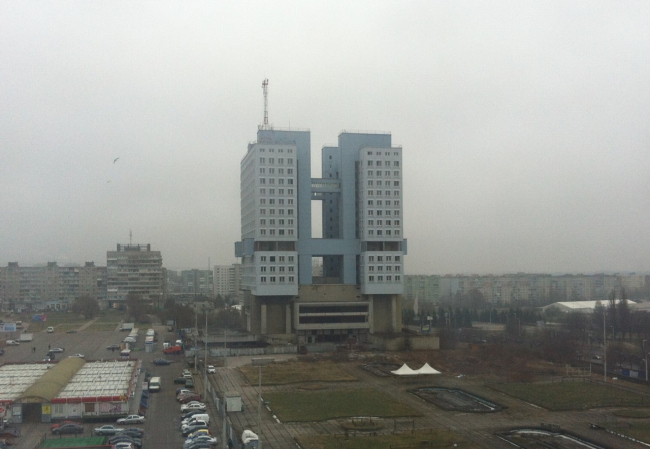
House of the Soviets. Source: Town-planning bureau “Heart of the City”, www.tuwangste.ru
The second prize was won by the trio of "Devillers et Associes (France) + Off-the-grid + Wall (Russia), and the two other prizes were awarded to Trevor Skempton from Great Britain and HOSPER Sweden from Sweden. In this issue, we are covering all the four projects.
***
2nd prize
Koenigsberg-Kaliningrad
Devillers et Associes (France) + Off-the-grid + Wall (Russia)
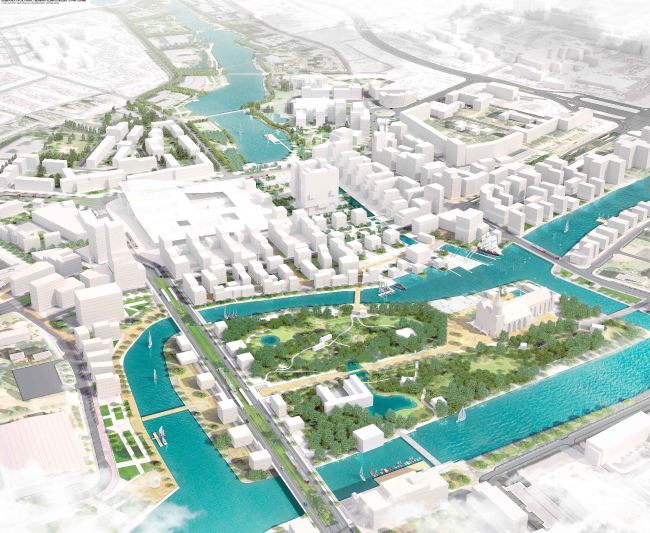
Contest project for the best concept of developing Kaliningrad's city center. 2nd place © Devillers et Associes (France) + Off-the-grid + Wall (Russia)
This team decided to pick up and develop the idea of duality of Koenigsberg-Kaliningrad that was proposed by the art critic Ivan Chechot: "Two centers, two cathedrals, two names, two K's (Kant and Kalinin, Kant and Koch, Kleist the writer and Kleist the general), two railway terminals, two lakes...", and give equal rights to the two already-existing city centers (one of them being the trade and business quarter, located in a different part of the city, the other, historical, located at the very heart of it).
The authors paid a lot of attention to the transportation layout, giving it a "pedestrian-friendly" quality. The three main transport thoroughfares - the Shevchenko Street, and the Moscow and Lenin avenues (just like in the project by HOSPER Sweden) will be turned into boulevards after the construction of the inside ring road. The architects insist on refraining from taking down trestle bridge but propose to improve it by adding broad sidewalks to it and then use it as a sightseeing platform commanding a fine view of the island.
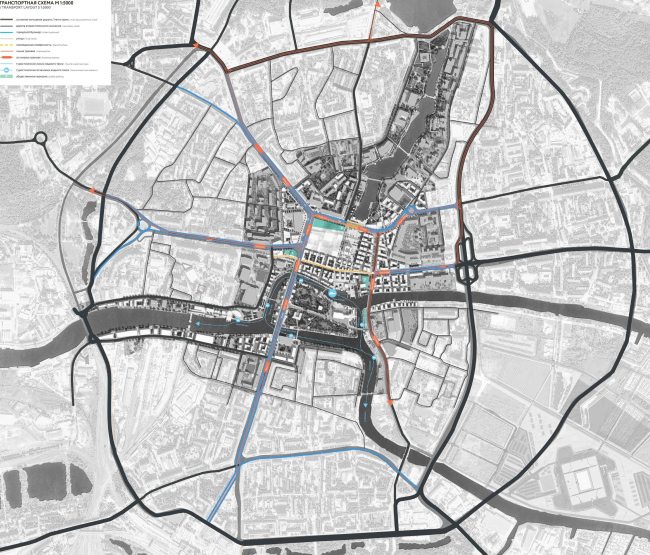
Contest project for the best concept of developing Kaliningrad's city center. 2nd place © Devillers et Associes (France) + Off-the-grid + Wall (Russia)
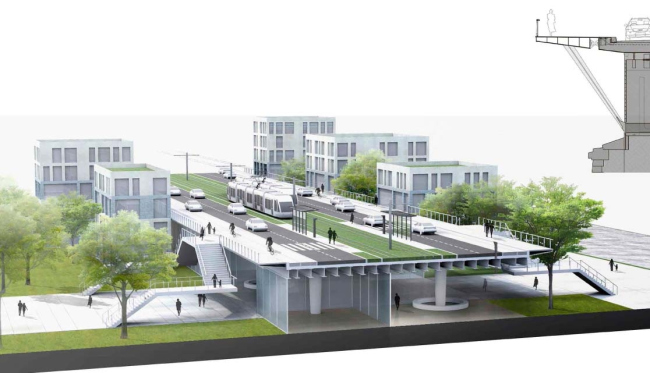
Contest project for the best concept of developing Kaliningrad's city center. 2nd place © Devillers et Associes (France) + Off-the-grid + Wall (Russia)
The authors of the project divide the whole territory into seven historical sectors. The main promenade near the Lower Lake will become the place for secluded leisure, quiet rest, and family picnics. The new forum on the central square next to the House of the Soviets becomes the place for the city's public events, and the House of the Soviets itself turns into a sightseeing platform with a panoramic cafe and a large screen for the sports broadcastings and movie showreels. The museum quarter next to the castle ruins becomes a multifunctional cultural center.

Museum center on the castle ruins. Contest project for the best concept of developing Kaliningrad's city center. 2nd place © Devillers et Associes (France) + Off-the-grid + Wall (Russia)
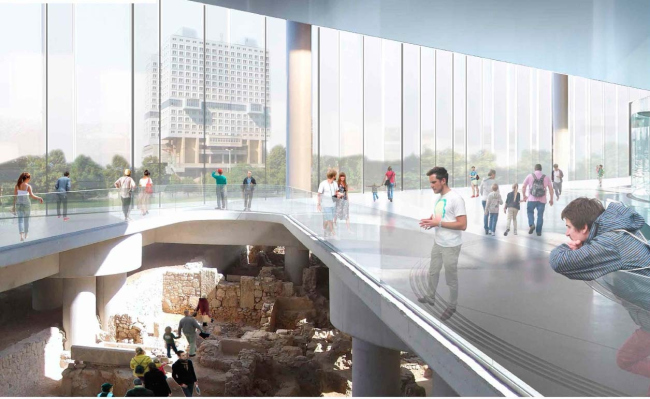
Contest project for the best concept of developing Kaliningrad's city center. 2nd place © Devillers et Associes (France) + Off-the-grid + Wall (Russia)
The contemporary architecture of the historical district of Alpstadt is based on revisiting the old European cities with their shops and cafés; the marina next to the embankment, a hostel on the moored boat, and a fish market. Named after Kant, the philosophical park on the Kneiphof Island is meant to become the "place for deep meditation two steps away from the city fuss" with libraries, discussion clubs, musical evenings, and exhibitions organized in the cathedral. The two other territories are the open university on the Kant Square and the "tourist paradise" on the Steindamm Street, the main pedestrian and shopping thoroughfare of the city.
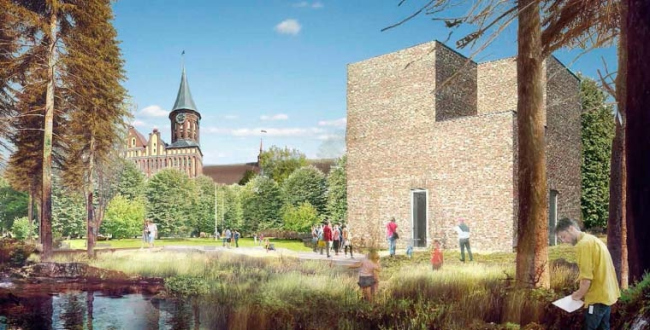
Contest project for the best concept of developing Kaliningrad's city center. 2nd place © Devillers et Associes (France) + Off-the-grid + Wall (Russia)
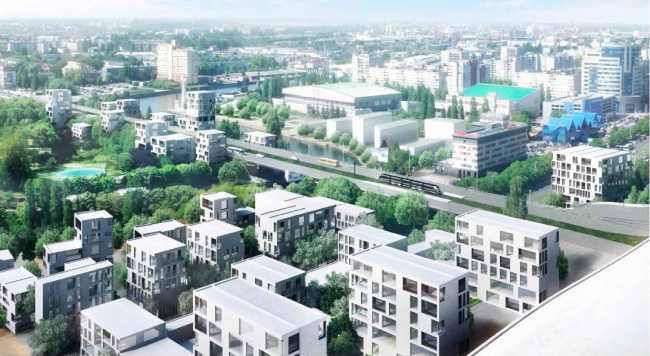
Contest project for the best concept of developing Kaliningrad's city center. 2nd place © Devillers et Associes (France) + Off-the-grid + Wall (Russia)
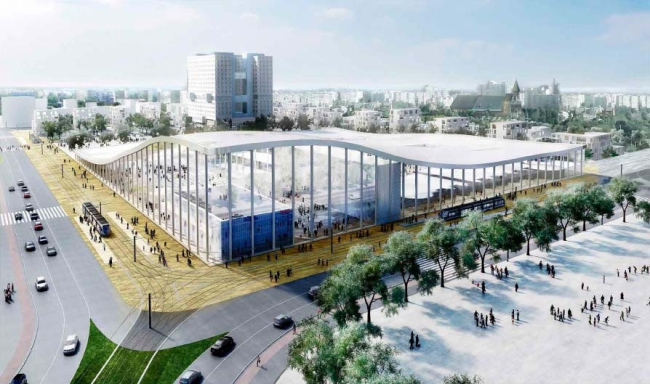
Contest project for the best concept of developing Kaliningrad's city center. 2nd place © Devillers et Associes (France) + Off-the-grid + Wall (Russia)
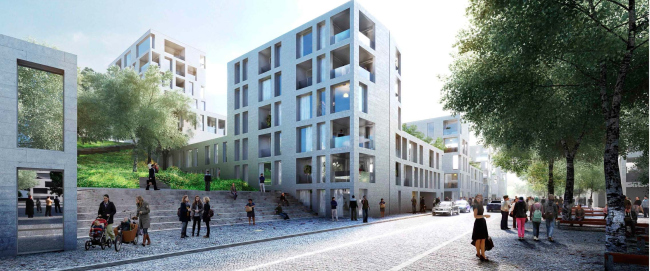
Contest project for the best concept of developing Kaliningrad's city center. 2nd place © Devillers et Associes (France) + Off-the-grid + Wall (Russia)
***
3rd prize
Three towers and one oculus
Trevor Skempton (Great Britain)
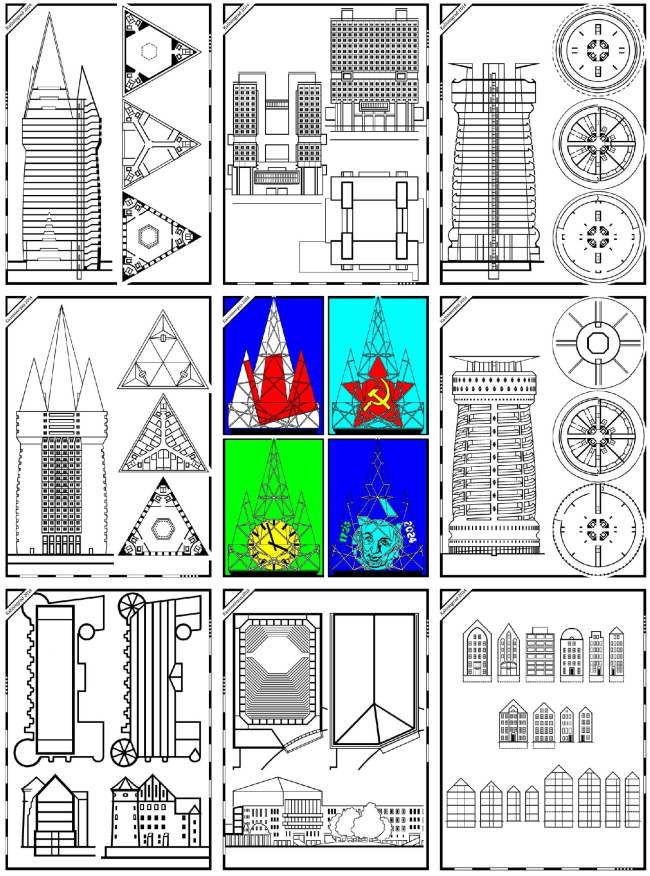
Contest project for the best concept of developing Kaliningrad's city center. 3rd place © Trevor Skempton (Great Britain)
What Skempton proposes is to complete the construction of the yet-unfinished House of the Soviets, renting it out to the commercial and governmental offices and augmenting it with two centerpieces, these being two multifunctional towers: "Gothic" 144 meters high and "Classic" 110 meters high, with the height of the House of the Soviets being about 70 meters. Connecting the towers with a multipurpose concert hall on the level of the basement floor, the author gets a "circular square" with a structure of underpasses around it, that he gives the name of "Oculus" and considers a worthy alternative to the long-term investments into the reconstruction of the Moscow and Lenin avenues. His project also provides for separating the pedestrian and the traffic flows, while the two new "centerpiece" towers are connected by the narrow pedestrian streets with the spire of the cathedral on the Kant Island.
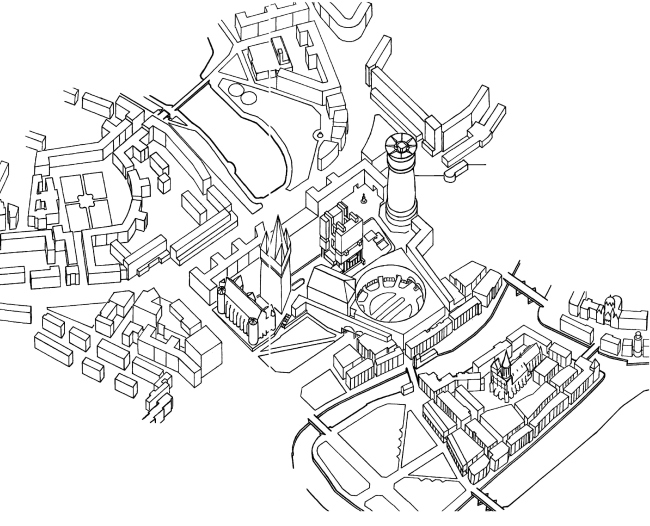
Contest project for the best concept of developing Kaliningrad's city center. 3rd place © Trevor Skempton (Great Britain)
It is planned that some of the houses standing between "Oculus" and the river will be restored, breaking away from the exactitude of the copying wherever necessary in order to fit the main architectural idea or to adjust to the current realities of the river bank. Skempton proposes to make the new houses seven-stories high, organizing on the first floors and in the mezzanines bars and restaurants, on the next two floors - offices, and apartments further up.
This modernist project is all about the homage to the soviet legacy; there is even something "post-soviet" about it because the construction of the high-rises is combined with the recreation of the lost buildings.
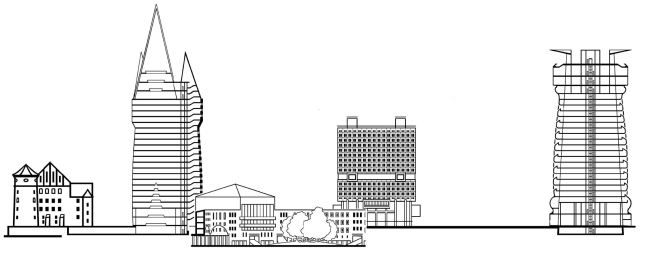
Contest project for the best concept of developing Kaliningrad's city center. 3rd place © Trevor Skempton (Great Britain)
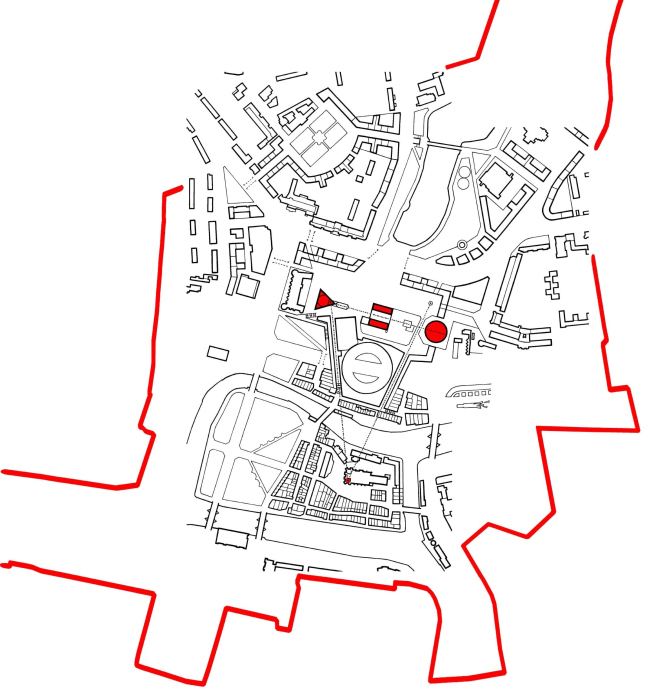
Contest project for the best concept of developing Kaliningrad's city center. 3rd place © Trevor Skempton (Great Britain)

Contest project for the best concept of developing Kaliningrad's city center. 3rd place © Trevor Skempton (Great Britain)
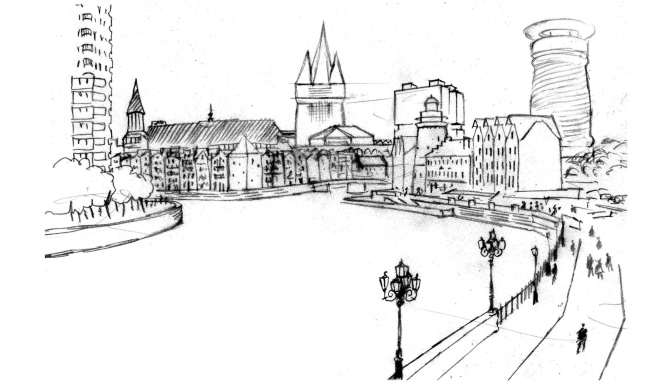
Contest project for the best concept of developing Kaliningrad's city center. 3rd place © Trevor Skempton (Great Britain)
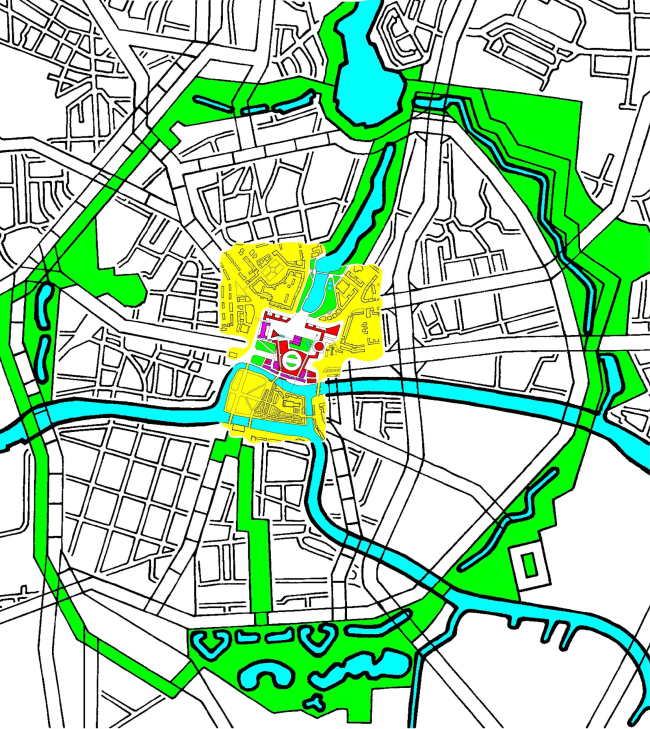
Contest project for the best concept of developing Kaliningrad's city center. 3rd place © Trevor Skempton (Great Britain)
***
3rd prize
HOSPER Sweden AB (Sweden)
Co-authors of Mandaworks AB and Andreas Jonasson Arkitektkontor ABC
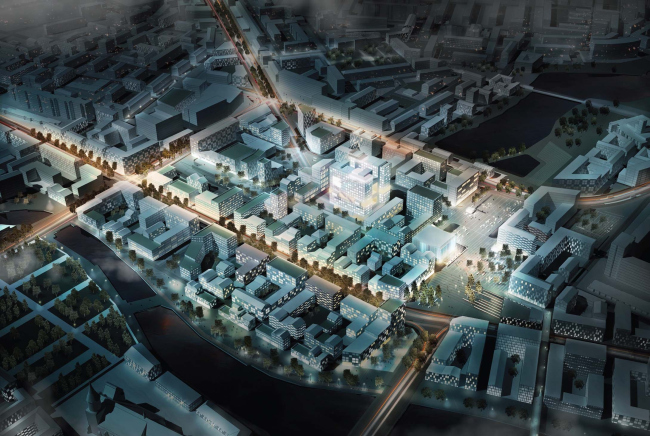
Contest project for the best concept of developing Kaliningrad's city center. 3rd place © HOSPER Sweden AB (Sweden), co-authors: Mandaworks AB and Andreas Jonasson Arkitektkontor AB
The authors propose a block plan with elements of "green" architecture and thought-out insolation. The blocks consist predominantly of five and six story houses and include elements of green architecture. The project also provides for green plants, good insolation, and actively uses the proximity to the reservoirs.
The main elements of the public territories are formed by the historical street grid the shape of which is slightly altered in the places where it overlaps with the legacy elements of both Koenigsberg's and the soviet periods. In order to avoid turning the city's downtown area into an isolated structure, the authors propose to continue the block planning in all the directions.
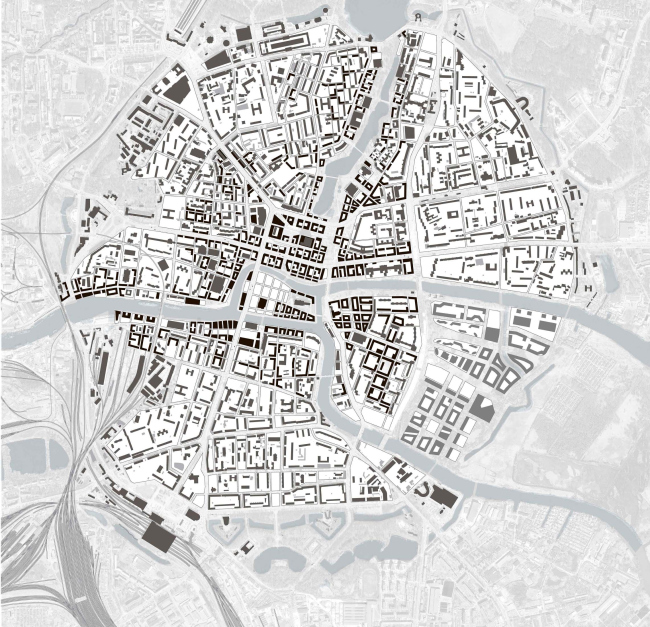
Contest project for the best concept of developing Kaliningrad's city center. 3rd place © HOSPER Sweden AB (Sweden), co-authors: Mandaworks AB and Andreas Jonasson Arkitektkontor AB
From the city's main thoroughfares, the traffic flows are routed both to the exits and entrances of the distribution road and to the streets of the residential part. Thank to such system, a lot of streets in the central part of the city can become predominantly pedestrian. The traffic-overloaded Lenin and Moscow avenues, as well as the Shevchenko Street, in the future will be turned into green, generally pedestrian, streets with limited automotive traffic.

Contest project for the best concept of developing Kaliningrad's city center. 3rd place © HOSPER Sweden AB (Sweden), co-authors: Mandaworks AB and Andreas Jonasson Arkitektkontor AB
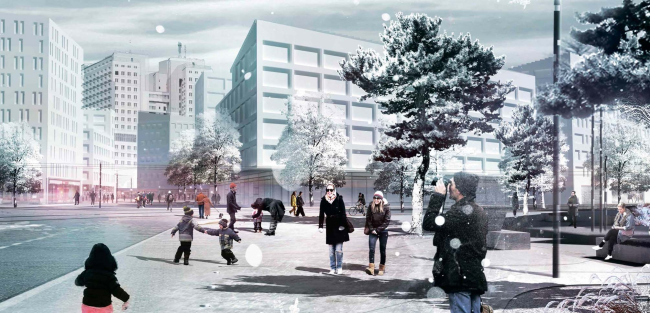
Contest project for the best concept of developing Kaliningrad's city center. 3rd place © HOSPER Sweden AB (Sweden), co-authors: Mandaworks AB and Andreas Jonasson Arkitektkontor AB
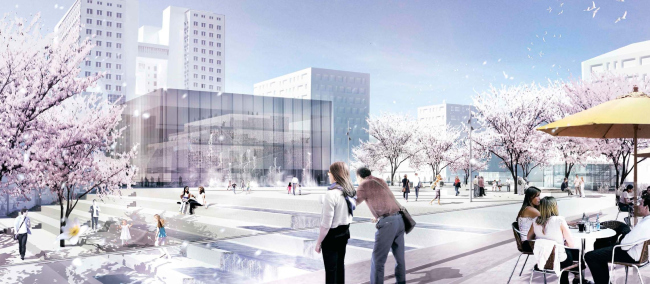
Contest project for the best concept of developing Kaliningrad's city center. 3rd place © HOSPER Sweden AB (Sweden), co-authors: Mandaworks AB and Andreas Jonasson Arkitektkontor AB
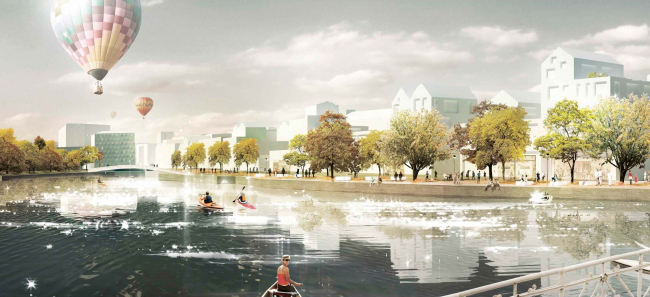
Contest project for the best concept of developing Kaliningrad's city center. 3rd place © HOSPER Sweden AB (Sweden), co-authors: Mandaworks AB and Andreas Jonasson Arkitektkontor AB

Contest project for the best concept of developing Kaliningrad's city center. 3rd place © HOSPER Sweden AB (Sweden), co-authors: Mandaworks AB and Andreas Jonasson Arkitektkontor AB
***
The contest for the concept of developing this territory was organized by the non-profit partnership organization "Town-planning Bureau "Heart of the City" at the commission of the government of the Kaliningrad region and with the support of the municipal board "Kaliningrad Urban District".
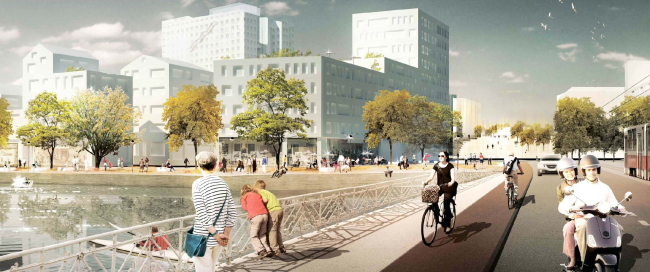
Contest project for the best concept of developing Kaliningrad's city center. 3rd place © HOSPER Sweden AB (Sweden), co-authors: Mandaworks AB and Andreas Jonasson Arkitektkontor AB
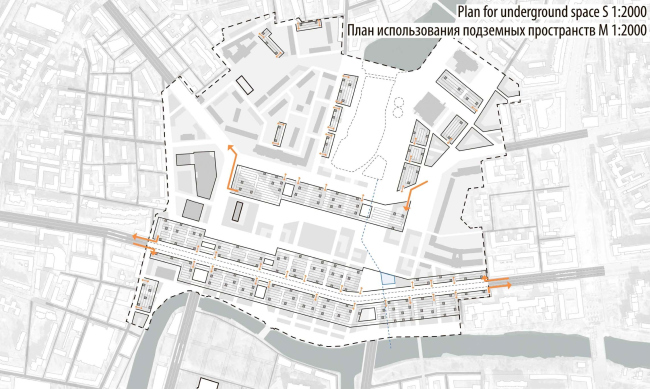
Contest project for the best concept of developing Kaliningrad's city center. 3rd place © HOSPER Sweden AB (Sweden), co-authors: Mandaworks AB and Andreas Jonasson Arkitektkontor AB
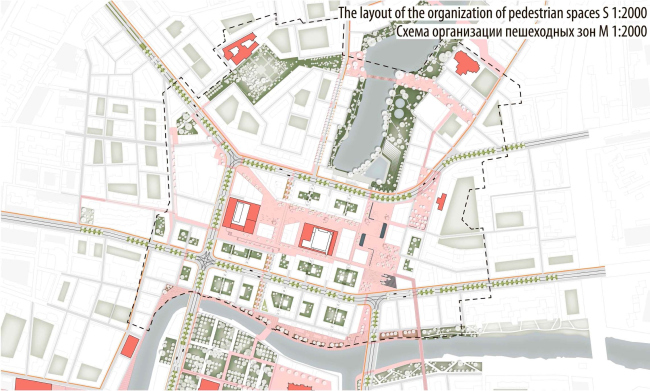
Contest project for the best concept of developing Kaliningrad's city center. 3rd place © HOSPER Sweden AB (Sweden), co-authors: Mandaworks AB and Andreas Jonasson Arkitektkontor AB
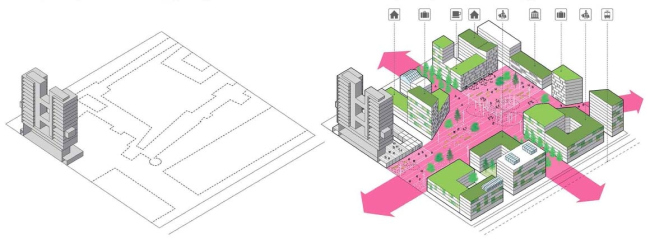
Contest project for the best concept of developing Kaliningrad's city center. 3rd place © HOSPER Sweden AB (Sweden), co-authors: Mandaworks AB and Andreas Jonasson Arkitektkontor AB
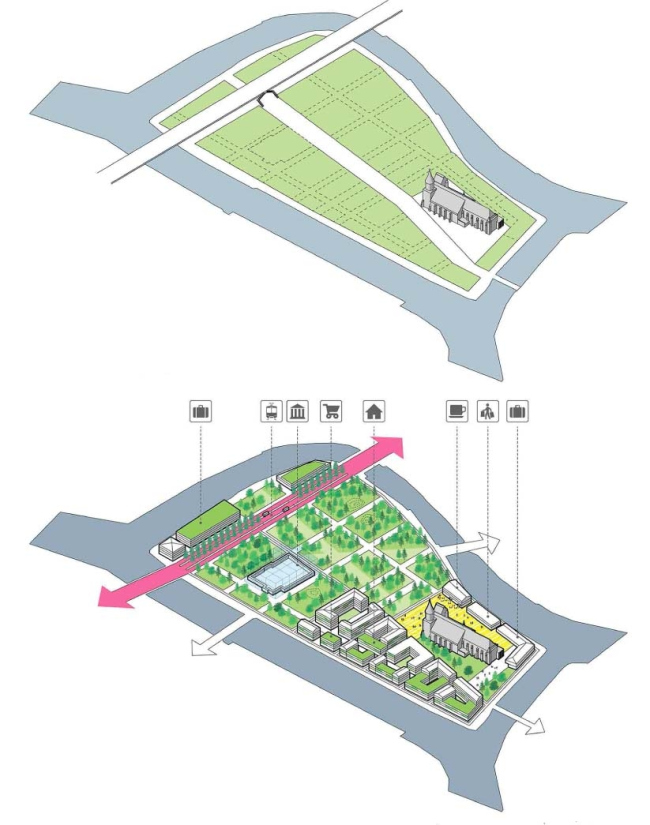
Contest project for the best concept of developing Kaliningrad's city center. 3rd place © HOSPER Sweden AB (Sweden), co-authors: Mandaworks AB and Andreas Jonasson Arkitektkontor AB

Contest project for the best concept of developing Kaliningrad's city center. 3rd place © HOSPER Sweden AB (Sweden), co-authors: Mandaworks AB and Andreas Jonasson Arkitektkontor AB

Contest project for the best concept of developing Kaliningrad's city center. 3rd place © HOSPER Sweden AB (Sweden), co-authors: Mandaworks AB and Andreas Jonasson Arkitektkontor AB







